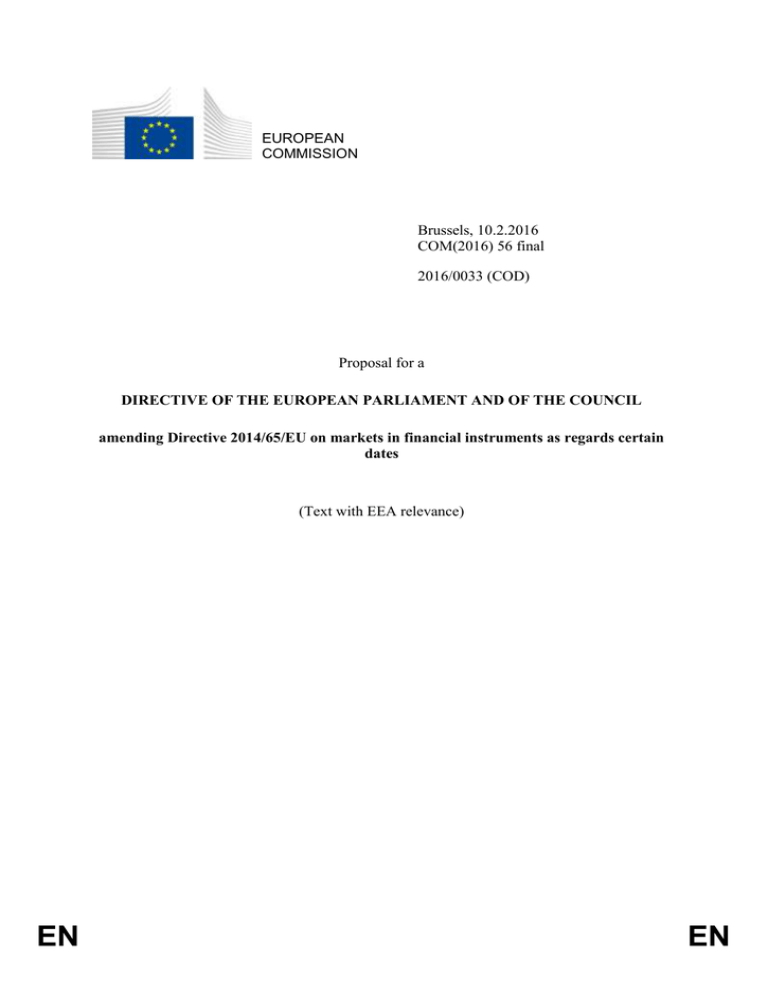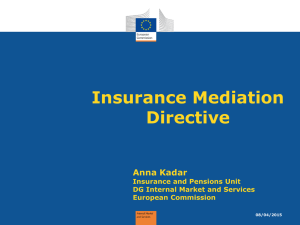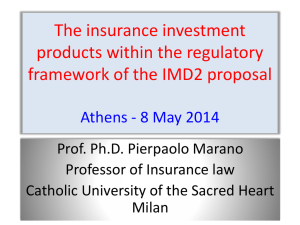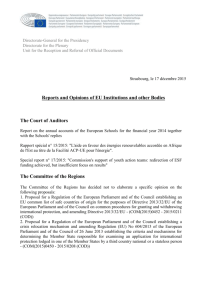2. legal basis, subsidiarity and proportionality
advertisement

EUROPEAN
COMMISSION
Brussels, 10.2.2016
COM(2016) 56 final
2016/0033 (COD)
Proposal for a
DIRECTIVE OF THE EUROPEAN PARLIAMENT AND OF THE COUNCIL
amending Directive 2014/65/EU on markets in financial instruments as regards certain
dates
(Text with EEA relevance)
EN
EN
EXPLANATORY MEMORANDUM
1.
CONTEXT OF THE PROPOSAL
1.1. Reasons for the proposal
Directive 2014/65/EU (‘MiFID’) together with Regulation (EU) No 600/2014 (‘MiFIR’) was
adopted in the wake of the financial crisis. MiFID and MiFIR, collectively referred to as
MiFID II, covers securities markets, investment intermediaries and trading venues. The new
framework reinforces and replaces the current MiFID framework.
MiFID II extends the number of financial instruments covered by trading rules and ensures
that trading takes place on regulated platforms. It introduces rules on high frequency trading.
It improves the transparency and oversight of financial markets – including derivatives
markets - and addresses the issue of price volatility in commodity derivatives. The new
framework improves conditions for competition in the trading and clearing of financial
instruments. Building on the rules already in place, the revised MiFID rules also strengthen
the protection of investors by introducing robust organisational and conduct of business
requirements. The MiFID II package consists of a Directive and a Regulation. Member States
need to transpose the Directive by 3 July 2016. Both MiFID and MiFIR are scheduled to
apply as of 3 January 2017.
The purpose of the draft proposal is to extend the entry into application of both instruments
that are comprised in the MIFID II package as a result of the technical implementation
challenges met by the European Securities and Markets Authority ('ESMA'), national
competent authorities ('NCAs') and stakeholders. These challenges are of such magnitude that
essential data infrastructures will not be in place in time for 3 January 2017.
During the legislative process, the very high level of complexity of the MiFID II package and
the need for a significant number of implementing measures were recognised. To this end, a
period of 30 months was foreseen between the adoption and the entry into application, instead
of the usual 18-24 months.
Despite this unusually long period, ESMA has made clear to the Commission that the
technical implementing challenges are of such magnitude that essential data infrastructures
will not be in place in time for 3 January 2017. If the date of entry into application remains
unchanged, this would mean, in practice, that neither competent authorities, nor market
participants, would be in a position to apply the new rules on 3 January 2017. This would lead
to legal uncertainty and potential market disruption.
In light of these exceptional circumstances and the particular technical implementation
challenges faced by ESMA and the competent authorities in this specific case, the
Commission deems it necessary to extend the entry into application of both instruments that
are comprised in MIFID II. Such extension shall be strictly limited to what is necessary to
allow the technical implementation work to be finalised.
1.2 The 'data' challenge
ESMA have informed the Commission that neither they nor NCAs will be in a position to
apply MiFID II as of 3 January 2017. This is a result of significant challenges in collecting the
data that is necessary for the operation of the MiFID II rules. In order to ensure legal certainty
and avoid potential market disruption, urgent action is therefore needed to adjust the date of
entry into application for MiFID II. The reasons for the urgency are linked to the need to
establish new and extensive electronic data collection networks between trading venues,
national regulators and ESMA.
EN
2
EN
The new framework requires trading venues and systematic internalisers to provide competent
authorities with financial instrument reference data that describes in a uniform manner the
characteristics of every financial instrument subject to the scope of MiFID II. Additional data
are also used for other purposes, in particular for the calculation of various liquidity and
transparency thresholds used for on-venue trading of all financial instruments covered by
MiFID as well as for positions reporting of commodity derivatives.
In order to collect data in an efficient and harmonised manner, a new data collection
infrastructure must be developed. This obliges ESMA, in conjunction with competent national
authorities, to establish a Financial Instruments Reference Data System ('FIRDS'). FIRDS will
need to cover the entire range of financial instruments that are included in the increased scope
of MiFID II. In accomplishing this task, FIRDS will necessitate linking of data feeds between
ESMA, NCAs and around 300 trading venues across the European Union. The vast majority
of the new IT-systems underpinning FIRDS will need to be built from the ground, based on
new parameters.
The Commission recognises that as a result of the size and complexity of the data needed to
be collected and processed for MiFID II to become operational, in particular for transaction
reporting, transparency calculations and reporting of positions in commodity derivatives,
neither stakeholders, such as trading platforms, nor NCAs nor ESMA are in a position to
ensure that the necessary data collection infrastructures would be in place and become
operational by 3 January 2017. Therefore, on 2 October 2015 ESMA informed the
Commission that a delay in the technical implementation of MiFID II was unavoidable.
1.3. The scope of the proposal
The absence of data has ramifications across multiple areas of MIFID II. As regards market
regulation, it is clear that without the foundation of reference data (instrument ID) and the
additional data infrastructures for transparency calculations and position reporting in place, it
will not be possible to apply the majority of the market rules. In particular:
Transaction reporting: without reference data, there will be challenges to determine
what instruments are within the scope. In addition, the necessary infrastructure for
market participants to report to their competent authorities will not be available.
Transparency framework: the trade transparency rules for all financial instruments
(equity as well as non-equity) cannot be established and applied. In addition, the
calculations and thresholds for the liquidity assessment, waivers, deferred publication
and, in the equity area, the double volume cap (which limits dark trading) cannot be
established.
Commodity derivatives: in the absence of position reporting for commodity
derivatives it will be very difficult to enforce position limits on such commodity
derivative contracts. With no position reporting, there is a limited ability to
effectively detect breaches of positon limits.
Microstructural regulation: many of the requirements in relation to algorithmic
trading/high frequency trading are by their nature dependent on data. In particular,
the key provisions on tick-size regime and the obligations in relation to market
making obligations and schemes are also tailored on there being a liquid market as
determined under the transparency framework.
The investor protection rules, the conduct of business rules and certain associated
organisational requirements under MIFID II will not be directly affected by the lack of data.
The important exception is the rules on best execution, where the scope of the disclosure is
EN
3
EN
designed by reference to there being a liquid market and other transparency concepts. For
other investor protection rules, aside from issues relating to the definition of financial
instruments or the scope of the legislation, data inter-linkages generally do not exist, as these
rules directly concern distribution and not trading. It is, therefore, recognised that an
alternative approach would be to extend the date of entry into application only for the parts of
the legislation directly relating to data collection.
However, after a careful analysis of that option, it appears that an extension for the whole
package, including investor protection rules, as opposed to a staggered approach is preferable:
It avoids the risk of causing confusion and unnecessary costs that stakeholders would
incur through a staggered implementation. Building various infrastructures
simultaneously – as opposed to doing so in stages - would make the process more
cost effective. For example, it avoids situations, where investment firms, involved in
execution of orders, would have to set up organisational requirements/conduct rules
in stages, which would be complicated, expensive and costly;
It avoids having to delineate between the areas that can be immediately implemented
and those that cannot be, and, therefore, avoids the risk of causing unintended
consequences which may not have been foreseen or sufficiently considered; and
It avoids the need for transitional rules, which by themselves would create new
issues and divert resources of ESMA, NCAs and stakeholders from building the
permanent framework.
On the basis of the above considerations, extending the entry into application for the entire
MiFID II rulebook is therefore necessary and justified.
1.4. Length of the extension
An extension of one year should provide sufficient and reasonable time for ESMA, NCAs and
operators to put in place the infrastructure for data collection, reporting and the transparency
threshold calculations. There are five steps in the implementation process: (1) business
requirements (which in this case are the necessary regulatory technical
standards/implementing technical standards), (2) specifications, (3) development (4) testing
and (5) deployment. ESMA estimates that it should complete these steps in relation to the
reference data, transparency calculations and position reporting systems by January 2018.
This assumes that there is sufficient legal clarity on the final requirements under the relevant
regulatory technical standards by mid-2016. On this basis, the draft proposal therefore extends
the entry into application of the whole framework until 3 January 2018 by one year.
The extension of entry into application of the measures of the Member States transposing
Directive 2014/65/EU should not impact adoption of delegated acts and technical standards to
be developed under Directive 2014/65/EU. The Commission should adopt these measures in
accordance with the procedure envisaged in order to allow the industry to set up and adjust
internal systems to ensure compliance with new requirements on the date of entry into
application of Directive 2014/65/EU.
2.
LEGAL BASIS, SUBSIDIARITY AND PROPORTIONALITY
•
Legal basis
The proposal is based on Article 53(1) of the TFEU. It is complementary to the proposed
regulation extending the entry into application of MiFIR.
EN
4
EN
•
Subsidiarity
According to the principle of subsidiarity, EU action may only be taken if the envisaged aims
cannot be achieved by Member States alone. EU intervention is needed to improve the proper
functioning of the internal market and avoid the distortion of competition in the field of
securities markets. In this regard, the legislation, that is being amended, is adopted in full
compliance with the principle of subsidiarity and any amendment thereto must be made
through a Commission proposal.
•
Proportionality
This EU action is necessary to achieve the objective of the proper implementation of data
collection infrastructure, as established by MIFID II. The extension as proposed in terms of
the scope and length is necessary to allow for an efficient and orderly planning and
implementation by all involved parties. This proposal will therefore ensure that the original
purpose of MIFID II of achieving a fully functioning internal market for securities services
with a high level of market transparency and investor protection can be attained.
3.
RESULTS
OF
EX-POST
EVALUATIONS,
CONSULTATIONS AND IMPACT ASSESSMENTS
STAKEHOLDER
This proposal is not accompanied by a separate Impact Assessment, as an impact assessment
for MIFID II has already been undertaken. This proposal does not alter MiFID II on substance
and does not impose new obligations on investment firms and trading venues or any other
operator covered by MiFID II. It only aims at providing - for exceptional reasons in particular
linked to the high complexity of the package and the data collection tools needed – an
extension of the date of entry into application of MiFID II by 1 year to provide legal certainty
and develop the necessary data collection infrastructures to ensure effective application and
enforcement of the new rules by ESMA and NCAs.
4.
BUDGETARY IMPLICATIONS
The proposal does not have a budgetary impact for the Commission.
EN
5
EN
2016/0033 (COD)
Proposal for a
DIRECTIVE OF THE EUROPEAN PARLIAMENT AND OF THE COUNCIL
amending Directive 2014/65/EU on markets in financial instruments as regards certain
dates
(Text with EEA relevance)
THE EUROPEAN PARLIAMENT AND THE COUNCIL OF THE EUROPEAN UNION,
Having regard to the Treaty on the Functioning of the European Union, and in particular
Article 53(1) thereof,
Having regard to the proposal from the European Commission,
After transmission of the draft legislative act to the national parliaments,
Having regard to the opinion of the European Central Bank1,
Having regard to the opinion of the European Economic and Social Committee2,
Acting in accordance with the ordinary legislative procedure,
Whereas:
(1)
Regulation (EU) No 600/2014 of the European Parliament and of the Council3 and
Directive 2014/65/EU of the European Parliament and of the Council4 are major
pieces of financial legislation adopted in the wake of the financial crisis as regards
securities markets, investment intermediaries and trading venues. The new framework
reinforces and replaces Directive 2004/39/EC of the European Parliament and of the
Council5.
(2)
Regulation (EU) No 600/2014 and Directive 2014/65/EU establish requirements in
relation to authorisation and operation of investment firms, regulated markets and data
reporting services providers. It harmonises position-limits regime for commodity
derivatives to improve transparency, support orderly pricing and prevent market abuse.
It also introduces rules on high frequency trading and improves oversight of financial
markets by harmonising administrative sanctions. Building on the rules already in
place, the new framework also strengthens the protection of investors by introducing
1
OJ C , , p. .
OJ C , , p. .
Directive 2014/65/EU of the European Parliament and of the Council of 15 May 2014 on markets in
financial instruments and amending Directive 2002/92/EC and Directive 2011/61/EU (OJ L 173,
12.6.2014, p. 349).
Regulation (EU) No 600/2014 of the European Parliament and of the Council of 15 May 2014 on
markets in financial instruments and amending Regulation (EU) No 648/2012 (OJ L 173, 12.6.2014,
p. 84).
Directive 2004/39/EC of the European Parliament and of the Council of 21 April 2004 on markets in
financial instruments amending Council Directives 85/611/EEC and 93/6/EEC and Directive
2000/12/EC of the European Parliament and of the Council and repealing Council Directive 93/22/EEC
(OJ L 145, 30.4.2004, p. 1).
2
3
4
5
EN
6
EN
robust organisational and conduct requirements. Member States are to transpose the
Directive 2014/65/EU by 3 July 2016.
EN
(3)
The new framework introduced by Regulation (EU) No 600/2014 and Directive
2014/65/EU requires trading venues and systematic internalisers to provide competent
authorities with financial instrument reference data that describe in a uniform manner
the characteristics of every financial instrument subject to that Directive. Those data
are also used for other purposes, for instance for the calculation of transparency and
liquidity thresholds as well as for positions reporting of commodity derivatives.
(4)
In order to collect data in an efficient and harmonised manner, a new data collection
infrastructure is being developed. To this end, the European Securities and Markets
Authority ('ESMA'), in conjunction with competent national authorities, are obliged to
establish a Financial Instruments Reference Data System ('FIRDS'). It will cover a
wide range of financial instruments brought into the scope of Regulation (EU) No
600/2014 and it will link of data feeds between ESMA, national competent authorities
('NCAs') and trading venues across the European Union. The vast majority of the new
IT-systems underpinning FIRDS will to be built from the ground, based on new
parameters.
(5)
Pursuant to Article 93 of Directive 2014/65/EU, the Member States are to apply the
measures transposing that Directive from 3 January 2017. However, due to the size
and complexity of the data to be collected and processed for the new framework to
become operational, in particular for transaction reporting, transparency calculations
and reporting of positions in commodity derivatives, stakeholders, such as trading
platforms, ESMA and NCAs are not in a position to ensure that the necessary data
collection infrastructures will be in place and become operational by that date.
(6)
The absence of the data collection infrastructures has implications across the entire
scope of Regulation (EU) No 600/2014 and Directive 2014/65/EU. Without data it
will not be feasible to establish a precise delineation of financial instruments that fall
within the scope of the new framework. Furthermore, it will not be possible to tailor
the pre-trade and post-trade transparency rules, in order to determine which
instruments are liquid and when waivers or deferred publication should be granted.
(7)
Absent the data, trading venues and investment firms will not be able to report
executed transactions to competent authorities. In the absence of position reporting for
commodity derivatives it will be difficult to enforce position limits on such contracts.
With no position reporting, there is a limited ability to effectively detect breaches of
the positon limits. Many of the requirements in relation to algorithmic trading are also
dependent on data.
(8)
The absence of data collection infrastructure will also make it difficult for investment
firms to apply best execution rules. Trading venues and systematic internalises will not
be able to publish data relating to the quality of execution of transactions on those
venues. Investment firms will not be provided with important execution data to help
them determine the best way to execute client orders.
(9)
In order to ensure legal certainty and avoid potential market disruption, it is necessary
and justified to take urgent action to extend the entry into application of the whole
framework, including all delegated and implementing acts.
(10)
The implementation process for data infrastructure involves five steps: business
requirements, specifications, development, testing and deployment. ESMA estimates
that those steps should be completed by January 2018 provided that there is legal
7
EN
certainty on the final requirements under the relevant regulatory technical standards no
later than by June 2016.
(11)
In light of the exceptional circumstances and in order to enable ESMA, NCAs and
stakeholders to complete the operational implementation, it is appropriate to defer the
date by which the Member States need to apply the measures transposing Directive
2014/65/EU and the date by which the repeal of Directive 2004/39/EC is to take effect
by 12 months until 3 January 2018. Reports and reviews should be deferred
accordingly.
(12)
Directive 2014/65/EU should therefore be amended accordingly,
HAVE ADOPTED THIS DIRECTIVE:
Article 1
Directive 2014/65/EU is amended as follows:
(1)
Article 90 is amended as follows:
(a)
in the first paragraph, ‘3 March 2019’ is replaced by ‘3 March 2020’;
(b)
the second paragraph is amended is follows:
(c)
(i)
‘3 September 2018’ is replaced by ‘3 September 2019’;
(ii)
‘3 September 2020’ by ‘3 September 2021’;
in the fourth paragraph, ‘1 January 2018’ is replaced by ‘1 January 2019’;
(2)
In the second subparagraph of Article 93(1), ‘3 January 2017’ is replaced by
‘3 January 2018’ and ‘3 September 2018’ by ‘3 September 2019’;
(3)
In Article 94, ‘3 January 2017’ is replaced by ‘3 January 2018’;
(4)
In Article 95(1), ‘3 July 2020’ is replaced by ‘3 January 2021’ and ‘3 January 2017’
is replaced by ‘3 January 2018’.
Article 2
This Directive shall enter into force on the twentieth day following that of its publication in
the Official Journal of the European Union.
Done at Brussels,
For the European Parliament
The President
EN
For the Council
The President
8
EN




